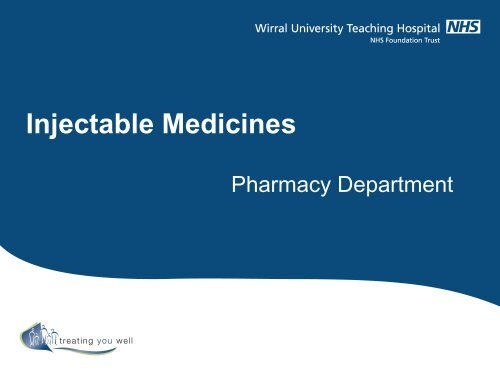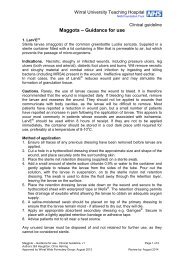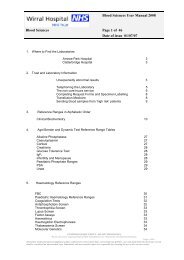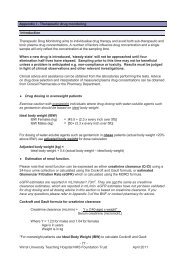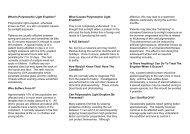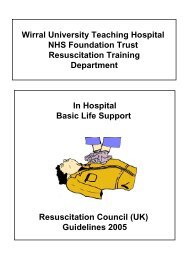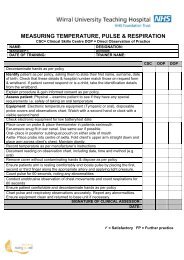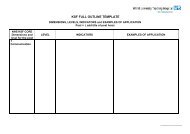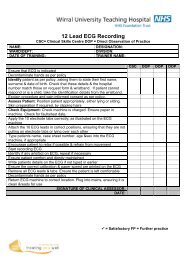Injectable Medicines
Injectable Medicines
Injectable Medicines
Create successful ePaper yourself
Turn your PDF publications into a flip-book with our unique Google optimized e-Paper software.
<strong>Injectable</strong> <strong>Medicines</strong><br />
Pharmacy Department
Housekeeping<br />
• Welcome & Registration<br />
• Fire<br />
• Facilities<br />
• Plan for today
Content<br />
• Risk of <strong>Injectable</strong> <strong>Medicines</strong><br />
• NPSA 20<br />
• Advantages and disadvantages<br />
• Different types of administration<br />
– Their advantages and disadvantages<br />
• Extravasation<br />
• Preparing medication for iv use<br />
• Stability<br />
• General Information
Risks To Patient Safety From<br />
<strong>Injectable</strong> <strong>Medicines</strong><br />
• The NPSA receives 800<br />
incident reports a month<br />
concerning injectable<br />
medicines.<br />
• 24% of all medication<br />
incident reports.<br />
• 58% of incident reports<br />
leading to death and<br />
severe harm
• Undertake a risk assessment of<br />
injectable procedures and<br />
products in clinical areas to<br />
identify high risks and develop<br />
an action plan to minimise them.<br />
• Ensure there are up to date<br />
protocols and procedures for<br />
prescribing, preparing and<br />
administering.<br />
• Ensure there is up to date<br />
technical information in clinical<br />
areas<br />
• Implement purchasing for safety<br />
strategies<br />
• Provide training and supervision<br />
• Audit – and annual report
Examples of other NPSA alerts<br />
relating to injectable medicines<br />
• Potassium<br />
• Epidurals<br />
• Insulin<br />
• Loading doses<br />
• Anticoagulants
Risks In Preparing And Administering<br />
<strong>Injectable</strong> <strong>Medicines</strong><br />
• Incomplete, Incorrect and ambiguous prescriptions<br />
• Transcription errors<br />
• Calculation errors (2 nd check vital)<br />
• Administration to the wrong patient.<br />
• Administration by the wrong route.<br />
• Administration at the wrong rate.<br />
• Unsafe handling or aseptic (non-touch) technique.
Risks In Preparing And Administering<br />
<strong>Injectable</strong> <strong>Medicines</strong><br />
• Selection of the wrong drug or diluent<br />
• Use of a drug or diluent or infusion after its expiry<br />
time and date<br />
• Incompatibility problems<br />
• Complex procedures/process before they can be<br />
used.<br />
• Failure to follow procedures e.g 2 nd check.<br />
• Failure to monitor infusions appropriately
Risks In Preparing And Administering<br />
<strong>Injectable</strong> <strong>Medicines</strong><br />
• Absence of multidisciplinary procedures<br />
• Lack of essential technical information<br />
• Health and safety risks to the operator or<br />
environment.<br />
• Variable levels of knowledge, training & competence<br />
amongst health care practitioners
Examples Of Incidents<br />
With <strong>Injectable</strong> <strong>Medicines</strong>
• Insulin – misread prescription/transcription error<br />
• Vincristine – wrong route<br />
• Potassium – wrong drug/incomplete mixing (No 2 nd check)<br />
• Morphine – SCBU multiple dilution/incorrect prescription<br />
• Heparin Infusion – wrong rate<br />
• Acetylcysteine – 800mg infusion prescribed instead of 8g<br />
• TPN – Nuffield report – Contaminated-post op sepsis<br />
• Gentamicin/Clindamicin Wrong drug – No 2 nd Check<br />
• Lack of monitoring – TPN infused over 4 hours- prescribed<br />
over 24hrs.<br />
• Vancomycin – Infused too rapidly – anaphylactic reaction
Why the <strong>Injectable</strong> Route?<br />
• Maintain Fluid balance in pts NBM/shock<br />
• Achieves high and predicable drug levels in acute<br />
situations<br />
• Pts who’s gut has to be rested<br />
• Pts intolerable oral medications<br />
• Drug unavailable orally
Advantages of IV route<br />
• Drug reaches circulation – minimum delay.<br />
• Maintain fluid balance or administer medication to<br />
patients unable to swallow e.g. unconscious or<br />
requiring gut rest.<br />
• Medication that is broken down in, or not absorbed<br />
from the gastro-intestinal tract.<br />
• To achieve high and predictable drug levels in acute<br />
situations<br />
• If injection required but injecting into skin would<br />
cause pain or trauma.
Disadvantages of IV route<br />
• Once injected no recall<br />
• Too rapid an injection can cause adverse effects on<br />
circulation or respiration<br />
• Anaphylactic reactions may be more severe in a<br />
sensitised individual<br />
• Danger of embolism<br />
• Increased risk of infection if aseptic technique poor<br />
• Haemolysis, agglutination, thrombophlebitis may be<br />
caused by hyper or hypotonic solutions
Methods of I.V administration<br />
• Continuous Infusion<br />
• Intermittent Infusion<br />
• Injection
Continuous Intravenous Infusion<br />
• IV administration of a volume of fluid with/out<br />
medication over a number of hours.<br />
• Large or small volume of fluids possible<br />
• Infusion bag<br />
• Syringe driver<br />
• Infusions prepared in clinical areas can only be<br />
infused for a max of 24 hours, these infusions must<br />
be changed after this time.
Advantages and Disadvantages to<br />
Continuous Infusion<br />
• Easy to maintain a constant therapeutic<br />
concentration<br />
• Good for medication with a short half life in the body<br />
BUT<br />
• Large volumes may lead to fluid overload<br />
• Incompatibility with diluent<br />
• Incomplete mixing may lead to layering
Intermittent Intravenous Infusion<br />
• IV administration over a set time period<br />
• Usually a small volume of fluid<br />
Useful for:<br />
• Achieving a high level of medication quickly but<br />
without the potential adverse effects of a bolus<br />
injection
Potential Problems with Infusions<br />
• Inappropriate dilution<br />
• Incompatibility issues<br />
• Incomplete mixing<br />
• Miscalculation of administration rate<br />
• Increased risk microbial/particulate contamination.<br />
• Flushing line<br />
• Risk of phlebitis/extravasation<br />
• Appropriate monitoring – essential this is done.
Intravenous Injection<br />
• A small volume of medication introduced directly into<br />
a cannula or the injection site of a giving set.<br />
• Bolus or push<br />
• Slow I.V injection 3 to 5 minutes
Advantages and Disadvantages of<br />
IV bolus Injections<br />
• Achieves immediate and high levels of medication<br />
BUT<br />
• If given too fast can result in adverse effects.<br />
• If too concentrated can damage veins<br />
• Patient has received entire dose if ADR becomes<br />
apparent
Extravasation<br />
Symptoms<br />
• Burning, stinging, discomfort at injection site<br />
• Resistance felt on plunger of syringe for bolus<br />
• Absence of free flow of fluid of infusion<br />
Actions<br />
• Stop infusion<br />
• Aspirate as much residual medication as possible<br />
• Elevate limb and apply warm pack<br />
• Refer to extravasation policy
Preparation of IV Products<br />
• Prepare products immediately before administration<br />
• Never prepare in advance and store in clinical areas.<br />
• Avoid working near a sink<br />
• Do not prepare if you are unwell – cold/skin lesion
Preparation of IV Products<br />
• I.V Infusions - Always use yellow I.V additive label<br />
• I.V injections use an I.V additive label if the product<br />
leaves the hands of the operator.<br />
• Always ensure the diluent/ infusion fluid is compatible<br />
with the drug.<br />
• If more than one drug in a bag/syringe - check<br />
• Ensure thorough mixing of product<br />
• Check for particulate contamination<br />
• Swab additive ports and allow to dry.
Stability Issues<br />
• A proportion of the drug will always be lost<br />
between preparation and administration if any<br />
of the following occur;<br />
– <strong>Medicines</strong> undergoes degradation<br />
– Interaction with diluent<br />
– Interaction with giving set
Factors affecting stability<br />
• pH<br />
• Light<br />
• Temperature<br />
• Time<br />
• Diluent<br />
• Oxidation
Compatibility<br />
• All drugs have potential to react with each other or<br />
their diluent<br />
• Check diluent/infusion fluid to be used<br />
• If more than one drug addition check compatibility<br />
• Precipitation, may be immediate or slow to form.<br />
• pH - main factor<br />
• Remember drugs may meet in the line<br />
• If unsure of compatibility – check
Incident Reporting<br />
• Any adverse incidents should always be<br />
reported via the trust incident reporting<br />
system.<br />
– Patient adverse reaction<br />
– Error in medication used<br />
– Fault with equipment<br />
– And anything else that concerns you!<br />
• Forms available via Intranet.
Checklist<br />
• Ensure injectable medicines prescribed appropriately<br />
• Use Commercially prepared infusions/injections.<br />
• Dose/infusion volume/infusion fluid/ rate/ timescale<br />
are present<br />
• 2 nd Check – Vital (Calculations,drug, volumes & dose<br />
etc)<br />
• Ensure well mixed<br />
• Aseptic technique at all times
Checklist<br />
• Incompatibilities/precipitation<br />
• I.V additive labels<br />
• Flushing<br />
• If unsure – check with<br />
– Prescriber<br />
– Pharmacy<br />
– <strong>Medicines</strong> guide<br />
– <strong>Injectable</strong> medicines guide (MEDUSA)<br />
– Royal Marsden procedures.
General information<br />
• <strong>Injectable</strong> medicines policy for the Trust<br />
• <strong>Medicines</strong> guide – via intranet<br />
• Has monographs and infusion charts for good<br />
range of drugs<br />
• I.V guide (MEDUSA) - via intranet<br />
• Provides information on how to prepare<br />
injectable medicines<br />
• Royal Marsden procedures/ Paediatric procedures<br />
available via the intranet.
<strong>Medicines</strong> Storage<br />
Why is this so important?We must ensure that<br />
these headlines never appear from our Trust.<br />
Stepping Hill hospital in Stockport<br />
where 4 people have died of<br />
possible insulin poisoning. Police are<br />
still trying to establish who has<br />
tampered with medicines<br />
£100,000 fine over<br />
hospital<br />
death<br />
A patient was administered epidural anaesthetic<br />
bupivacaine instead of saline solution.<br />
The two drugs had “almost identical packaging” and her<br />
life could have been saved if the bags were kept in<br />
separate cupboards.<br />
The trust had pleaded guilty to an offence under the<br />
Health and Safety at Work Act. An inquest at Trowbridge,<br />
Wiltshire, two years ago ruled that this patient was<br />
unlawfully killed, also citing the “chaotic” drug storage
Responsibilities<br />
• It is the responsibility of the ward manager to ensure the<br />
overall safe custody and storage of medicinal products at<br />
ward level. However, it is the responsibility of all nursing<br />
staff to ensure that all the points on the following slides are<br />
adhered to.<br />
• Matron spot checks are now carried out monthly & each<br />
ward will be classed as Red, Amber or Green status. This<br />
information will be displayed on a Trust dashboard and any<br />
recurring problems will be escalated to senior<br />
management.<br />
•Make sure that your ward area scores Green!!
Keys must be held by a registered<br />
practitioner<br />
Fridges must be kept locked ,<br />
temperature maintained between 2<br />
and 8 0 C and monitored daily<br />
Air tube cupboard to be kept locked.<br />
Registered practitioner to empty<br />
cupboard when the red light shows
CD order books must be locked away and CD<br />
cupboards must not be identified to<br />
highlight contents<br />
Deliveries of medicines from Pharmacy must be<br />
signed for by a registered practitioner. The<br />
person signing for the bag must put the<br />
medicines in the locked medicines<br />
room/cupboards promptly<br />
Bedside medicines lockers must be kept<br />
locked. All patient’s own drugs must be<br />
stored in here
Medicine room must be locked and all<br />
medicines put away in locked<br />
cupboards.<br />
The medicines returns box must be kept in a<br />
locked cupboard<br />
IV fluids must be kept:<br />
- In a locked room<br />
- On shelves<br />
- In original containers and not mixed
• Any Questions?


